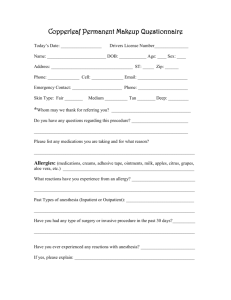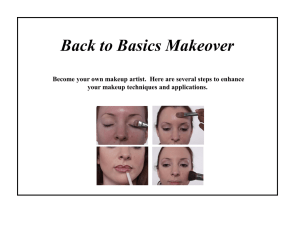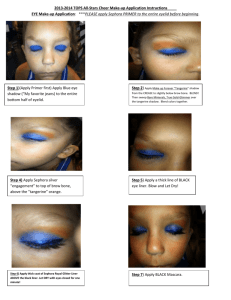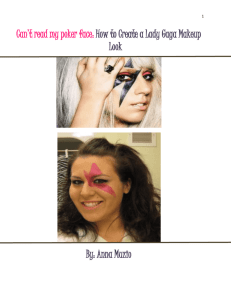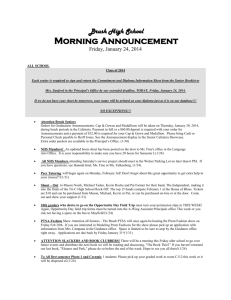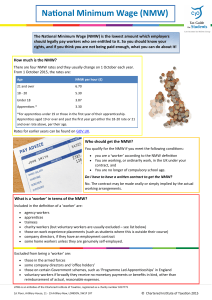professional makeup application
advertisement
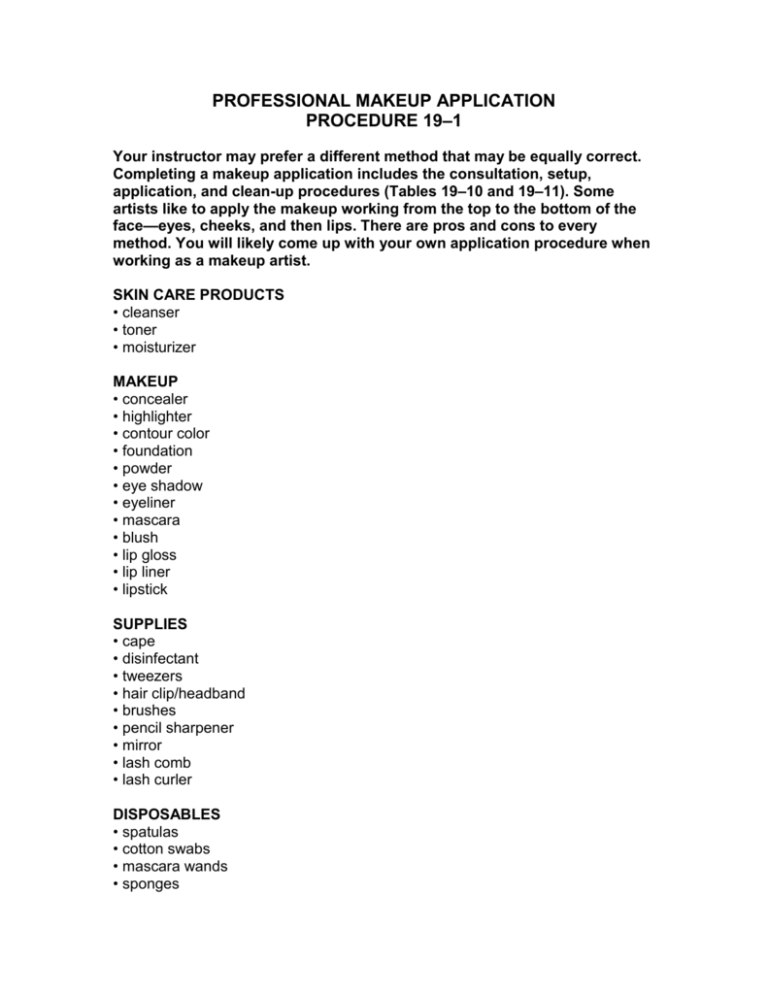
PROFESSIONAL MAKEUP APPLICATION PROCEDURE 19–1 Your instructor may prefer a different method that may be equally correct. Completing a makeup application includes the consultation, setup, application, and clean-up procedures (Tables 19–10 and 19–11). Some artists like to apply the makeup working from the top to the bottom of the face—eyes, cheeks, and then lips. There are pros and cons to every method. You will likely come up with your own application procedure when working as a makeup artist. SKIN CARE PRODUCTS • cleanser • toner • moisturizer MAKEUP • concealer • highlighter • contour color • foundation • powder • eye shadow • eyeliner • mascara • blush • lip gloss • lip liner • lipstick SUPPLIES • cape • disinfectant • tweezers • hair clip/headband • brushes • pencil sharpener • mirror • lash comb • lash curler DISPOSABLES • spatulas • cotton swabs • mascara wands • sponges • tissues • applicators Preparation 1. Determine the client’s needs, and choose products and colors accordingly (Figure P19–1-1). Focus on your client’s features and preferences. Discussing skin care or waxing is appropriate with a makeup client. Ask the following questions: • Do you wear contacts or have allergies? • What look do you want? • What makeup products do you normally wear? • What are your typical clothing colors? • What is the special occasion or event? 2. Wash your hands. 3. Drape the client and use a headband or hair clip to keep her hair out of her face (Figure P19–1-2). Procedure Basic Makeup Applications Preparing the face is like preparing a painting canvas for the palette of colors. The skin needs to be exfoliated and hydrated for the makeup to be applied successfully. 4. Cleanser. After washing your hands, cleanse the face if the client is wearing makeup or if the skin is oily. 5. Toner. Use a cotton pad to apply the toner or witch hazel to cleanse the skin (Figure P19–1-3). 6. Moisturizer. Apply a moisturizer to prepare the skin for makeup (Figure P19–1-4). 7. Lip conditioner. Use a spatula to get the product out of the container. Apply with a brush (Figure P19–1-5). To give it more time to soak in and moisturize, put on the lip conditioner when starting the makeup application. 8. Concealer. Use a spatula to get the product out of the container. Choose a color one to two shades lighter than the foundation. You can apply this under or over the foundation beneath the eyes with a brush, sponge, or finger (Figure P19–1-6). It can also be used as the highlighter. Note: Always use creams and liquids before applying powders, or they will not blend. If you are using a powder concealer or contour powder, apply these after the foundation. 9. Foundation. Choose two colors to match the right shade. Use a spatula to get the product out of the container, or put some on a clean sponge or in a small container (Figure P19– 1-7a,b). Apply to the jawline to match the skin color (Figure P19–1-8). Cover the skin to even out the skin tone and cover imperfections without over-rubbing the skin. Blend along the jaw and edges of the face (Figure P19–1-9). Blend downward to blend with facial hair and up around the hairline so the product does not stick in the hairline. 10. Highlighter. Use a spatula to get the product out of the container. Apply a white or light color to accentuate and bring out features along the brow bone, the temples, chin, or above the cheek bones. Blend with your brush, a sponge, or your finger (Figure P19–1-10). 11. Contouring. Use a spatula to get the product out of the container. Apply a darker shade under the cheekbones and to other features you want to appear smaller (Figure P19–1-11). 12. Powder. Pour a little powder on a tissue to avoid cross contamination. Apply to the brush and tap off excess powder onto the tissue. Use a powder brush or puff, and sweep downward all over the face to set the foundation (Figure P19–1-12). 13. Eyebrows. Use a shade that is close to the hair color, or a shade the client likes. Apply color by using a pencil or cake eye shadow with a brush (Figure P19–1-13). Smudge with your finger, going in the opposite direction of the hair growth to blend. Then smooth back into place with a brow brush. 14. Eye shadow. Choose a light base color and apply all over the eyelid, from the lash line up to the brow. Stop color at the outside corner of the eye up to the outside corner of the brow (Figure P19–1-14). Apply a darker shade to the crease: partially on top of the crease and partially underneath the crease. First tap the excess powder off the brush. Apply the color from the outside corner of the eye to the area above the inside of the iris (Figure P19–1-15). Blend the color (Figure P19–1-16). Optional: Apply the eyeliner before applying the dark shadow color. 15. Eyeliner. Sharpen the liner before and after use. Wet liner can also be used with a disposable or sanitized brush. Eye shadow can be applied as liner with a thin brush dipped in water; dry shadow can also be applied with a thin, firm brush for a more natural look. Make sure the liner is not too rough or so dry that it drags on the eye. Have the client shut her eyes when you apply the liner on top of the eyelids. Then have her look up and away as you apply the lower liner under the eyes (Figure P19–1-17). Apply to the top and bottom edge of the eye on the outside of the lashes. Bring the liner three-fourths of the way to the center of the eye, ending softly at the inside of the iris. Blend so that the color tapers off. Bringing the liner closer to the nose can make the eyes appear closer together. Lining only the outside corner makes the eyes appear farther apart. Blend the liner with a firm, small liner brush (Figure P19–1-18). 16. Mascara. Dip a disposable brush into the mascara. Wipe off the excess. Have the client look down and focus on a fixed point to apply mascara to the top of the lashes (Figure P19–1-19). Comb with a lash comb before the product dries. Then have the client put her chin down while looking up at the ceiling to apply mascara to the bottom lashes. Comb before the client looks down to avoid smudging under the eye. 17. Blush. The blush color will depend on whether you choose a warm or cool color scheme. Tap off the excess powder on the brush. Apply blush just below the cheekbones, blending on top of the bones toward the top of the cheeks. The color should stop below the temple and not be closer than two fingers away from the nose. It should not go lower than the nose, because this can “drag down the face.” Blush should blend to the hairline, but not into it. Do not apply too much blush on the apple of the cheek; this makes the face look fatter. A horizontal line makes the face appear wider, whereas a vertical line makes it look thinner. Following the cheekbones usually works best (Figure P19–1-20). 18. Optional: Lip conditioner/lip gloss. This step applies if you did not already apply lip moisturizer in step 4. Use a spatula to get the product out of the container. Use a brush to apply. Put on a gloss or lip moisturizer when starting the makeup application, so it can soak in and moisturize before you start applying the liner. If the lips have too much gloss, the liner will not stick. 19. Lip liner. Sharpen the liner. Have the client smile and stretch her lips. With the lips pulled tight, the liner and lipstick brush glide on more smoothly. Line the outer edges of the lips first; then fill in and use the liner as a lipstick (Figure P19– 1-21). This keeps the lipstick and color on longer. 20. Lipstick. Use a spatula to get the product out of the container. Have the client select a color from among two or three choices. Apply the lipstick evenly with a lip brush. Rest your ring finger on the client’s chin to steady your hand. Ask the client to relax her lips and part them slightly. Brush on the lip color. Then ask the client to smile slightly so that you can smooth the lip color into any small crevices (Figure P19–1-22). Blot the lips with tissue to remove excess product and set the lip color (Figure P19–1-23). 21. Show the client the finished application (Figure P19–1-24). Clean-Up and Sanitation After the service is completed (and before the clean-up), fill out the client chart and make retail product suggestions and sales. 22. Wash your hands. 23. 24. 25. 26. 27. Discard all disposable items, such as sponges and applicators. Disinfect implements such as eyelash curlers and tweezers. Clean and disinfect brushes. Place washable items in the laundry. Disinfect product containers, used supplies, and the workstation.
